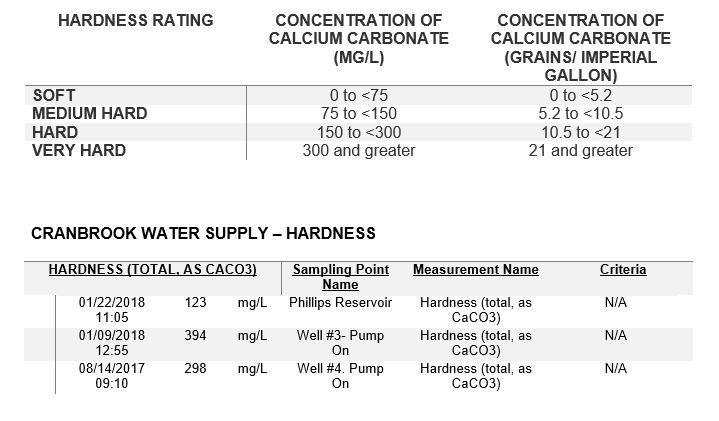What is water hardness?
Water hardness is caused by calcium and magnesium in the ground and surface water. If either of these minerals are present in your drinking water in high concentrations, the water is considered hard. These minerals come from rock such as limestone that dissolves in our river system. The result of hard water is difficulty making lather or suds for washing and a build-up of minerals on taps and other fixtures.
Water containing low concentrations of calcium or magnesium is called soft water. Municipalities with soft drinking water often have higher incidences of water pipe corrosion (low pH). The degree of hardness in drinking water is commonly classified in terms of its concentration of calcium carbonate:

Are there health issues with water hardness?
There are no known health effects associated with calcium and magnesium minerals in drinking water. However, conventional water softening systems (those that use salts) may not be suitable for people on sodium-reduced diets.
We recommend that consumers thoroughly research the various water softener systems available before deciding whether or not to soften their water. Also, water softeners should be connected so that the water you are drinking is not softened.
Can water hardness affect dishwashers and washing machines?
Hard water can reduce the effectiveness of detergent. Hard water may also cause automatic dishwashers or washing machines to leave film on dishes or leave residue on clothing, and can also cause mineral build-up on mechanical parts.
The easiest solution to hard water problems is to increase the amount of detergent used in proportion to the degree of water hardness. Check with your appliance user manual or the manufacturer for instructions.
How do water softeners work?
Water softeners replace the non-toxic hard minerals with sodium or potassium. The amounts added are relatively insignificant compared to what you ingest from your food. They should not pose health problems, unless you are on a salt-reduced diet.
Most water softeners regenerate with salt and water. Regeneration is a process where the softening materials (called resins) inside the softener can be used over and over again. Once regeneration is completed, the salt and water solution is flushed into the sewer and into the environment. A correctly operating water softener will use salt and water efficiently, saving you money while reducing the impact on the environment.
 Cranbook
Cranbook


